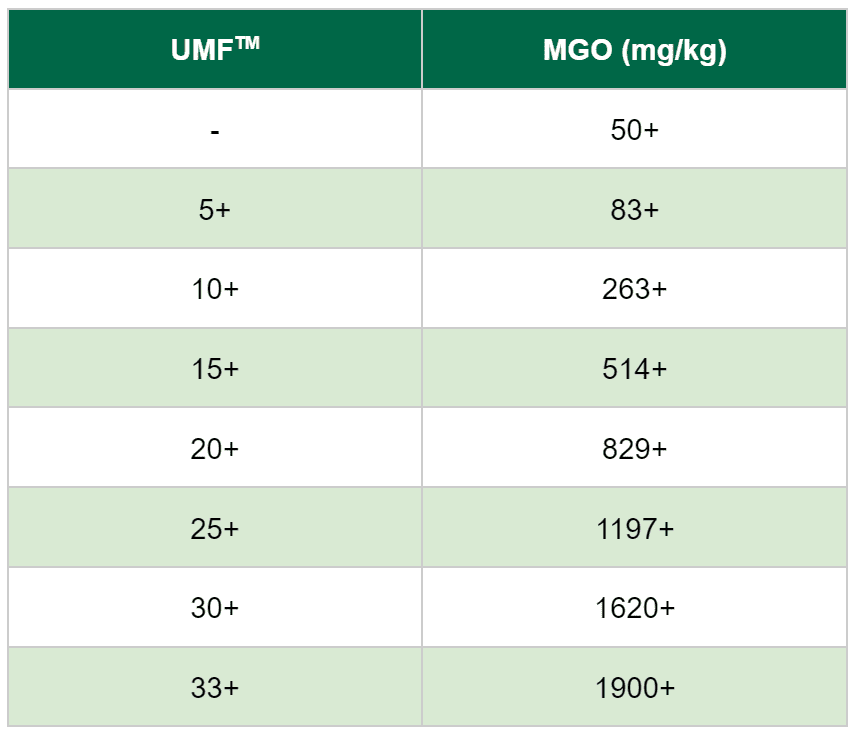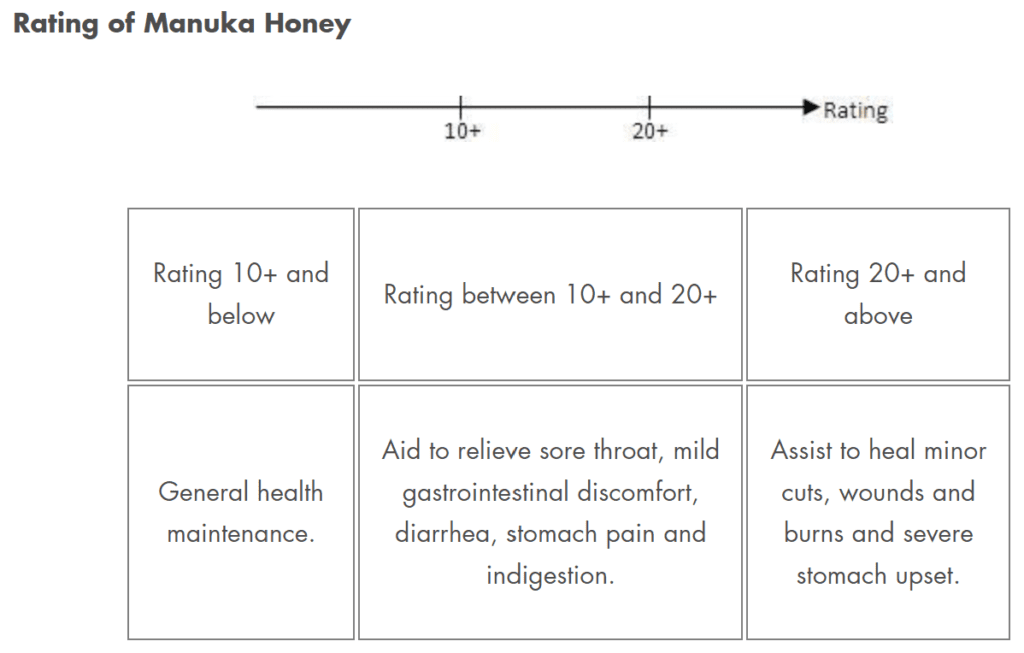My wife and I recently returned from a wonderful week in New Zealand having experienced a new culture and suite of flavors. One of these flavors was mānuka honey, an ingredient I was only vaguely familiar with, mostly due to its seemingly exorbitant price tag. After learning more about it and purchasing some to bring back, here’s what I learned. In the process, I uncovered some unanswered questions, too.
Mānuka 101
Mānuka honey is a product derived from a flowering plant called leptospermum scoparium, morecommonly referred to by its native Māori name, mānuka. Mānuka is a shrub- or bush-type tree indigenous to New Zealand and Southeast Australia whose nectar is collected by bees, transported back to the hive, and transformed into the honeycomb that will eventually be harvested and processed into the product we use and eat.
It is worth noting during the honey-making process, bees add two important enzymes, invertase and glucose oxidase, that give all honey unique properties (more on these later).
Why is Mānuka Honey So Expensive?
Simply put, mānuka honey is so expensive because it is a rare, limited production commodity that can only be produced in Oceania where the mānuka plant grows (a similar dynamic to the exclusivity of French champagne). Additionally, there is a difference between Australian and New Zealand mānuka honey that likely influences mānuka’s price point: Australian mānuka can be derived from any plant in the leptospermum species, while New Zealand mānuka is strictly monofloral (i.e., coming from only one species, that being leptospermum scoparium).
On the latter point, mānuka honey is subject to stringest quality and testing standards. One of the mānuka industry-endorsed quality assurance systems called UMFTM (or Unique Mānuka Factor) can be used to translate the purity and potency of the mānuka honey into a standard language everyone can understand. The UMF composite rating considers several attributes of the honey, including:
- Potency – represented by MGO (methylglyoxal) concentration, which is most important compound present in mānuka honey that bestows many of its beneficial health qualities (much more on this shortly)
- Authenticity – represented by the presence of leptosperin, which is a compound found only in mānuka flower nectar
- Shelf life – represented by DHA, or dihydroxyacetone, which is slowly converted to MGO; the higher the DHA, the longer the shelf life
- Freshness – represented by HMF, or hydroxymethylfurfural, a compound ensuring the honey hasn’t been exposed to excess heat or over storage that would impair the honey’s properties
The UMF scale starts at 5+ and can exceed 30+, though anything over 30 is exceedingly rare. While not directly convertible, the UMF rating correlates with a minimum threshold of MGO content in the honey (hence “+”, meaning “or more”), with higher ratings representing higher levels of MGO and, in turn, higher prices. As a peculiar fun fact, exported mānuka honey is subject to strict quality controls, whereas mānuka honey sold within New Zealand is not.

Source: New Zealand Honey Co.; Health Philosophe
With such a wide-ranging scale, how are we to know which grade of mānuka honey should be used for what purpose?
Health Benefits of Honey
Before delving into the unique health benefits of mānuka honey, it is worth explaining the inherent qualities of all genuine honey, compliments of the aforementioned bees.
First, during the nectar collection and honeycomb construction process, bees introduce an enzyme called invertase. Invertase breaks down the sucrose-rich nectar molecule into smaller, simpler components glucose (blood sugar) and fructose (fruit sugar). In humans, invertase helps maintain a healthy digestive system by breaking down sugars so they are more readily converted into energy. It also acts as an antiseptic, antioxidant, and immune booster to prevent diseases.1,2 However, humans do not produce invertase and hence must obtain it through the diet. Further, as we age, we have less access to invertase, which impairs our ability to derive important nutrients from food.2,3
A second enzyme bestowed by bees during the honeycomb construction process is glucose oxidase. In a similar fashion to invertase, glucose oxidase breaks down the nectar into byproducts, this time gluconic acid and hydrogen peroxide. Hydrogen peroxide, a type of bleach (yes, bleach), is known to inhibit the growth of yeast and bacteria4 and therefore can serve as a natural preservative. Consequently, under the right conditions (namely, sealed with limited water), honey can remain unspoiled for years, if not indefinitely.
With that overview of all honey in mind, there are a few benefits specific to mānuka honey that make it potentially much more powerful.
Health Benefits Unique to Mānuka Honey
Methylglyoxal (MGO) may arguably be the most potent compound found in mānuka honey in terms of its potential health benefits to humans. New Zealand mānuka honey is the most commonly researched honey for its health and medicinal properties, which have revealed antibacterial, antioxidant, and anti-inflammatory benefits. Practically, the avoidance or prevention of infection from various strains of bacteria would seem to suggest a potential lowering in the risk of conditions like tooth decay and gum disease (mouth bacteria)5, eye inflammation (eye bacteria)6, and even some cancers caused by infection such as stomach cancer (h. pylori bacteria)7,8,9. Topically, mānuka honey’s multi-pronged effects draw water from wounds while maintaining a microbe-resistant environment, making it an all-around health product6.
Last but certainly not least, building on the previous discussion around hydrogen peroxide, mānuka honey exhibits what is known as non-peroxide activity (NPA)10, defined as having an antibacterial effect absent hydrogen peroxide, which is largely attributed to the presence of MGO. Net, NPA is yet another element contributing to mānuka’s overall catalog of “anti’s” that fight infection and help prevent disease.
Despite this manifesto on the purported benefits of mānuka honey, there still remain some unanswered questions that would help guide practical applications.
Unanswered Questions
The foremost unanswered question relates to dose. Although the literature suggests a convincing association between the properties of mānuka honey and the prevention of certain bacteria-driven diseases, there is relatively little guidance on the proper dose to achieve the desired effect. Moreover, the varying levels of MGO and fact that honey is a highly concentrated sugar would imply a one-size-fits-all dose is likely inappropriate (e.g., insulin-sensitive athlete vs. diabetic). Last, mānuka honey is not considered a supplement or pharmaceutical, but rather a food that doesn’t come with recommended doses, thereby leaving the user to their own imagination.
In New Zealand, the anecdotal dose for general health and immunity ranged from 1 teaspoon to 1 tablespoon to “one generous spoonful” daily independent of potency, though it would stand to reason that 1 teaspoon of a UMF 5+/MGO 83+ product would have a vastly different effect compared to a UMF20+/MGO 829+ version. That said, there was a consistent narrative that the higher the MGO content, the more medicinal the application.

Source: Nature’s Farm
As a corollary of dosing, it is unclear whether the benefits of daily mānuka honey consumption in any quantity would outweigh the risks of (effectively) chronic sugar supplementation (i.e., 1 tablespoon per day). More broadly, it is unlikely that nutrition research would convincingly demonstrate an inverse correlation between mānuka honey consumption and the prevalence of disease. Said differently, do populations who consume more mānuka honey exhibit a lower prevalence of, say, stomach cancer, all else being equal? Instead, literature to date suggests beneficial health effects of mānuka honey, but perhaps not to the level to be regarded as medicine or preventative of disease.
All in, the purported benefits of mānuka honey appear well researched, but without the benefit of dosing or frequency recommendations, it is difficult to translate the literature into a practical application with any more specificity than “consume in moderation.” Instead, mānuka honey can be added as another ingredient in our nutritional armamentarium, exposing us to essential enzymes and hopefully bestowing antimicrobial benefits alongside a kicker of benign sweetness.
Sources:
- Kulshrestha, S., Tyagi, P., Sindhi, V., & Yadavilli, K. S. (2013). Invertase and its applications – A brief review. Journal of Pharmacy Research, 7(9), 792–797. https://doi.org/10.1016/j.jopr.2013.07.014
- Manoochehri, H., Hosseini, N. F., Saidijam, M., Taheri, M., Rezaee, H., & Nouri, F. (2020). A review on invertase: Its potentials and applications. Biocatalysis and Agricultural Biotechnology, 25, 101599. https://doi.org/10.1016/j.bcab.2020.101599
- Invertase Guide – Uses, Benefits, Before/After, Side Effects (genemedics.com)
- Patton, T. E., Barrett, J., Brennan, J. J., & Moran, N. (2006). Use of a spectrophotometric bioassay for determination of microbial sensitivity to manuka honey. Journal of Microbiological Methods, 64(1), 84–95. https://doi.org/10.1016/j.mimet.2005.04.007
- Abdelhadi Hbibi, Khadija Sikkou, Khadija Khedid, Sakina El Hamzaoui, Amal Bouziane, Driss Benazza, Antimicrobial activity of honey in periodontal disease: a systematic review, Journal of Antimicrobial Chemotherapy, Volume 75, Issue 4, April 2020, Pages 807–826, https://doi.org/10.1093/jac/dkz527
- Albietz, J., & Schmid, K. L. (2017). Randomised controlled trial of topical antibacterial Manuka (Leptospermum species) honey for evaporative dry eye due to meibomian gland dysfunction. Clinical and Experimental Optometry, 100(6), 603–615. https://doi.org/10.1111/cxo.12524
- Sains Malaysiana 49(2)(2020): 411-420 http://dx.doi.org/10.17576/jsm-2020-4902-20
- Daniel Yordanov, Lyudmila Boyanova, Rumyana Markovska, Juliana Ilieva, Nikolay Andreev, Galina Gergova, Ivan Mitov, “Influence of Dietary Factors on Helicobacter pylori and CagA Seroprevalence in Bulgaria”, Gastroenterology Research and Practice, vol. 2017, Article ID 9212143, 7 pages, 2017. https://doi.org/10.1155/2017/9212143
- Helicobacter pylori (H. pylori) and Cancer – NCI
- Johnston, M., McBride, M., Dahiya, D., Owusu-Apenten, R., & Nigam, P. S. (2018). Antibacterial activity of Manuka honey and its components: An overview. AIMS microbiology, 4(4), 655–664. https://doi.org/10.3934/microbiol.2018.4.655
